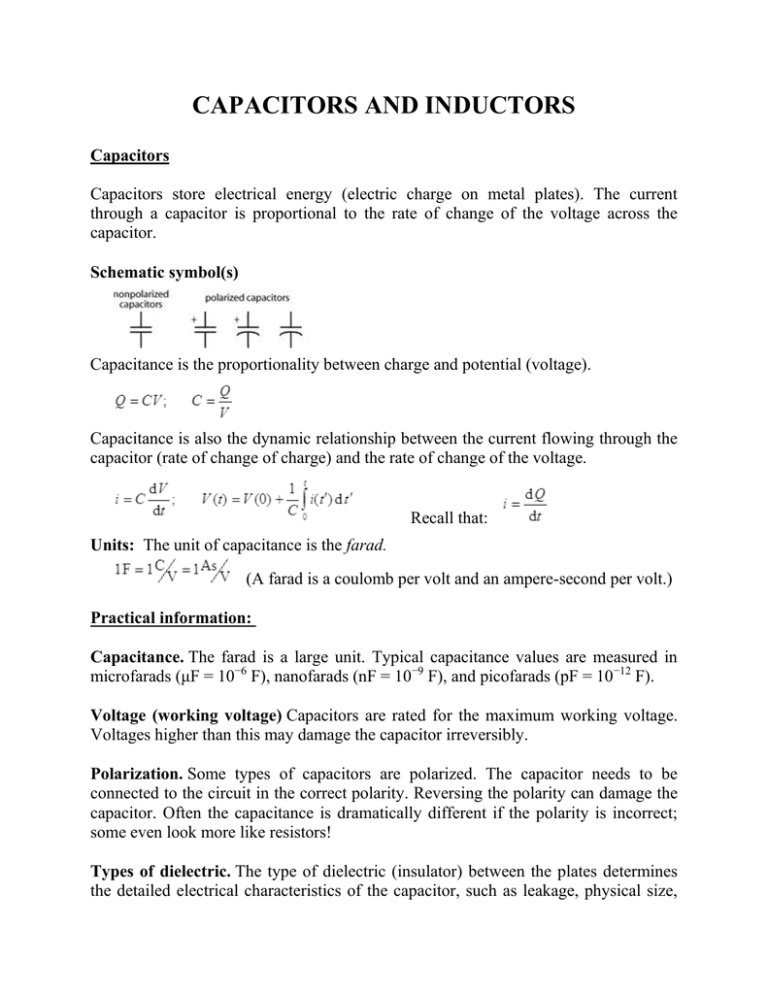CAPACITORS AND INDUCTORS
advertisement

CAPACITORS AND INDUCTORS Capacitors Capacitors store electrical energy (electric charge on metal plates). The current through a capacitor is proportional to the rate of change of the voltage across the capacitor. Schematic symbol(s) Capacitance is the proportionality between charge and potential (voltage). Capacitance is also the dynamic relationship between the current flowing through the capacitor (rate of change of charge) and the rate of change of the voltage. Recall that: Units: The unit of capacitance is the farad. (A farad is a coulomb per volt and an ampere-second per volt.) Practical information: Capacitance. The farad is a large unit. Typical capacitance values are measured in microfarads (μF = 10−6 F), nanofarads (nF = 10−9 F), and picofarads (pF = 10−12 F). Voltage (working voltage) Capacitors are rated for the maximum working voltage. Voltages higher than this may damage the capacitor irreversibly. Polarization. Some types of capacitors are polarized. The capacitor needs to be connected to the circuit in the correct polarity. Reversing the polarity can damage the capacitor. Often the capacitance is dramatically different if the polarity is incorrect; some even look more like resistors! Types of dielectric. The type of dielectric (insulator) between the plates determines the detailed electrical characteristics of the capacitor, such as leakage, physical size, and high frequency performance. In this class we will not be concerned with these details. It is however necessary to understand that these details are responsible for the wide variety of shapes, sizes, colors, and types of capacitors. Capacitors in parallel: The equivalent capacitance of capacitors in parallel is the sum of the capacitances of all of the capacitors. Capacitors in parallel: Capacitors in series: The equivalent capacitance of capacitors in series is the reciprocal of the sum of the reciprocals of the capacitances of all of the series capacitors. Capacitors in series: Inductors Inductors store magnetic energy (magnetic field of a coil). The voltage across an inductor is proportional to the rate of change of the current through the inductor. Schematic symbol(s) Inductance is the proportionality between the voltage across an inductor and the rate of change of the current through it. The unit of inductance is the henry. (A henry is a volt-second per ampere.) Practical information: Inductance. Typical inductance values are measured in henries (H), millihenries (mH = 10−3 H) and microhenries (μH = 10−6 H). Series resistance. The ideal inductor has zero resistance, however real inductors are made from many turns of wire. The resistance of the wire is often significant and can be included in the circuit model as a resistor in series with the inductor. Core materials. The inductance of a coil can be greatly increased by placing a magnetic material inside the coil. The type of magnetic material inside the coil determines the detailed electrical characteristics of the inductor, such as eddy current losses and high frequency performance. In this class we will not be concerned with these details. It is however necessary to understand that these details are responsible for the wide variety of types of inductors. Inductors in parallel: The equivalent inductance of inductors in parallel is the reciprocal of the sum of the reciprocals of the inductances of all of the parallel inductors. Inductors in parallel: Inductors in series: The equivalent inductance of inductors in series is the sum of the inductances of all of the inductors. Inductors in series: Source : http://www.nhn.ou.edu/~bumm/ELAB/Lect_Notes/ RC_RL_transients_v1_2_3.html



